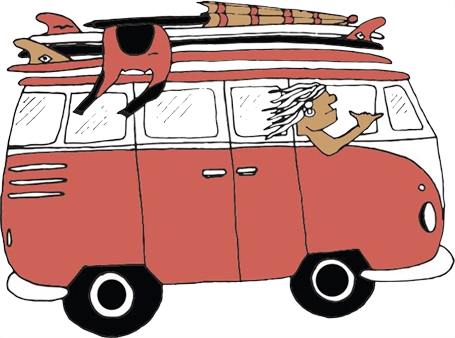8 SURFING MANEUVERS TO MASTER BEFORE YOU SHOULD CLAIM TO SURF
1. FIND THE LINE UP WITH AN EFFICIENT DUCK DIVE:
Let’s face it, surfing is just a lot of paddling and a few waves in between. And it’s the duck dive that brings the surfer to the table to play. But it’s tricky: the timing, the push, the release — there’s a lot to juggle while you’re tossed around in a washing machine of waves. To ace this skill, practice in still water (pools, lakes, flat days) for the muscle memory, then apply it to actual surf. Remember, the wave’s curl is a circle so whatever’s happening above the surface is happening below. So judge the depth by looking at the wave then use the energy to your advantage (physics!). If your board is too buoyant to sink, try a turtle roll: flip the board on top of you to let the wave wash over you and the board. Hang on tight. Letting go is a hazard for fellow surfers. It also means losing your floatation device and your one-way ticket back to the surface.
2. KNOWING WHEN TO GO AND WHEN TO DROP IN:
Once you’re past the breakers, you’re ready to take a wave. The surfer closest to the wave’s curl has the right of way. So if you’re thinking about going right and there’s someone catching the wave to your left, don’t go (and vice versa). Burn someone and you just may get the Miki Dora treatment.
3. THE BUILDING BLOCK FOR ALL OTHER MOVES IS THE BOTTOM TURN:
Your surfing game is nothing without a bottom turn. It’s the set-up, it’s the connector, it’s really the first turn you learn. Pictured above is the classic, oft-copied, Tom Curren bottom turn. Note the hand skimming the water, the back knee dropped — it’s poetry in motion.
4. THE BEND AND (FRONTSIDE) SNAP:
It was once rumored that the reason why Kelly Slater is so good is because his back is double-jointed. Even if you’re not blessed with such physical attributes, the frontside snap is still within reach. Look where you want to go out of your bottom turn then use your shoulders to initiate the turn, letting your back leg drive the arc and the front leg guide it. Start small and work toward going vertical (à la Slater).
5. FLIP IT AND REVERSE IT WITH THE BACKSIDE SNAP:
It’s usually harder to surf your backside than your frontside. But once you get the hang of it, you may find it easier to go more vertical and throw more spray while surfing this direction. It’s the same concept as the fronthand turn except the upper body plays a more critical role for initiating the turn.
6. THE CUTBACK THAT KEEPS THE PARTY GOING:
Taylor Knox is touted as one of the best rail-to-rail surfers of his era. Watching him surf is a thing of beauty. But even he must admit that part of his tutorial is wrong. The eyes (and head) should look first and then the body should follow. So mute the sound while you study his movements — and the lines he draws in the waves — to learn his textbook cutty. Note: he does make a good point about moving that back foot further toward the tail for more drive through the three-point turn.
7. CROSSTEP YOUR SURF GAME TO THE NEXT LEVEL:
Even if you’re a sworn shortboarder for life, a competent surfer should know how to crosstep a longboard. Opening the mind to moving your feet on your board will unlock new surfing possibilities. Plus, feeling the weight transfer throughout the length of a log can translate into a better understanding of building speed on waves on shorter boards.
8. ALWAYS FINISH ON A POSITIVE NOTE WITH A STYLISH EXIT:
The best indicator of a shoddy surfer is a thrown away board at the end of a wave. Even if the end is in the whitewater, follow Alex Knost’s lead and step hard onto the surfboard’s tail and exit out the back. If bailing on your board is already a bad habit, surf without a leash and be cured in a matter of a couple waves.













